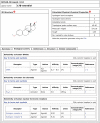IUPHAR-DB: new receptors and tools for easy searching and visualization of pharmacological data
- PMID: 21087994
- PMCID: PMC3013670
- DOI: 10.1093/nar/gkq1062
IUPHAR-DB: new receptors and tools for easy searching and visualization of pharmacological data
Abstract
The IUPHAR database is an established online reference resource for several important classes of human drug targets and related proteins. As well as providing recommended nomenclature, the database integrates information on the chemical, genetic, functional and pathophysiological properties of receptors and ion channels, curated and peer-reviewed from the biomedical literature by a network of experts. The database now includes information on 616 gene products from four superfamilies in human and rodent model organisms: G protein-coupled receptors, voltage- and ligand-gated ion channels and, in a recent update, 49 nuclear hormone receptors (NHRs). New data types for NHRs include details on co-regulators, DNA binding motifs, target genes and 3D structures. Other recent developments include curation of the chemical structures of approximately 2000 ligand molecules, providing electronic descriptors, identifiers, link-outs and calculated molecular properties, all available via enhanced ligand pages. The interface now provides intelligent tools for the visualization and exploration of ligand structure-activity relationships and the structural diversity of compounds active at each target. The database is freely available at http://www.iuphar-db.org.
Figures
References
Publication types
MeSH terms
Substances
LinkOut - more resources
Full Text Sources
Medical
Molecular Biology Databases
Research Materials
Miscellaneous



